It may be the greatest creation in sweet tooth history: Crème Brûlée Donuts. Soft, pillowy, fried dough, a creamy custard center, all with crunchy caramel topping the entire affair. Here you’ll find detailed instructions, photos for each step of the recipe, and pro tips galore! First time making donuts? I promise they’ll be a raging success.
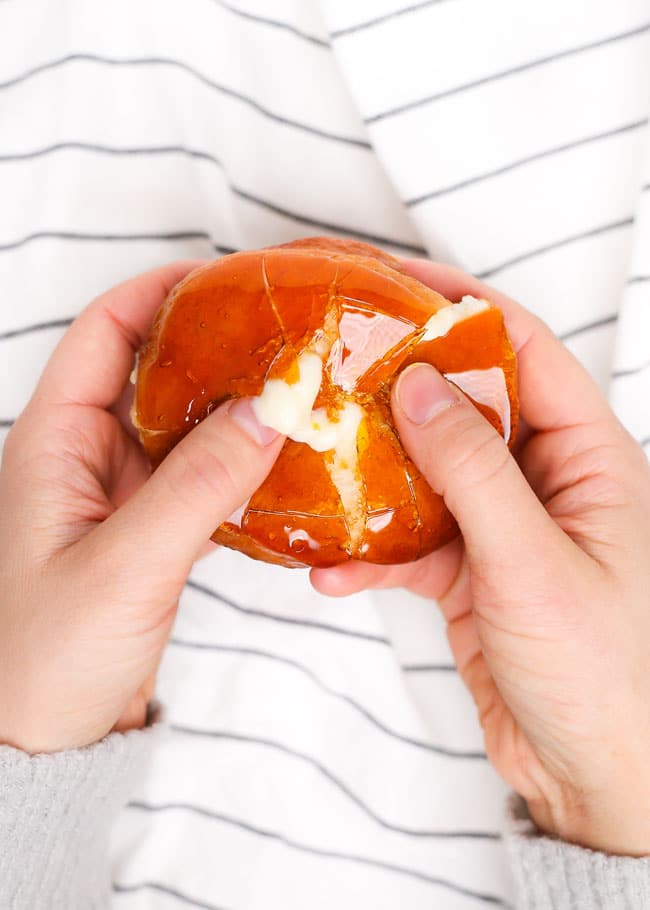
When we’re winding down at the end of the night, watching food videos in bed is a practice we never skip out on. We recently saw a video featuring something so simple, yet so incredible. Crème brûlée donuts. The video was purely food-porn inspiration with no recipe. I felt that the world NEEDED to have these donuts. This is my own rendition of the idea, and I do have to say, without bragging too much, that they were out-of-this-world.
As someone who once feared the unknown that is yeast, I have everything you need to know detailed in this post. All the common mistakes, the reasons why they happen, and how to fix the problem without having to waste ingredients. Yeast doughs are a skill I’ve slowly built up to get to where I’m at today. I’ve made every mistake in the book, and lived to tell the tale! Now, when I’m whipping up dough, it feels so easy. Well, because it is! Practise makes perfect.
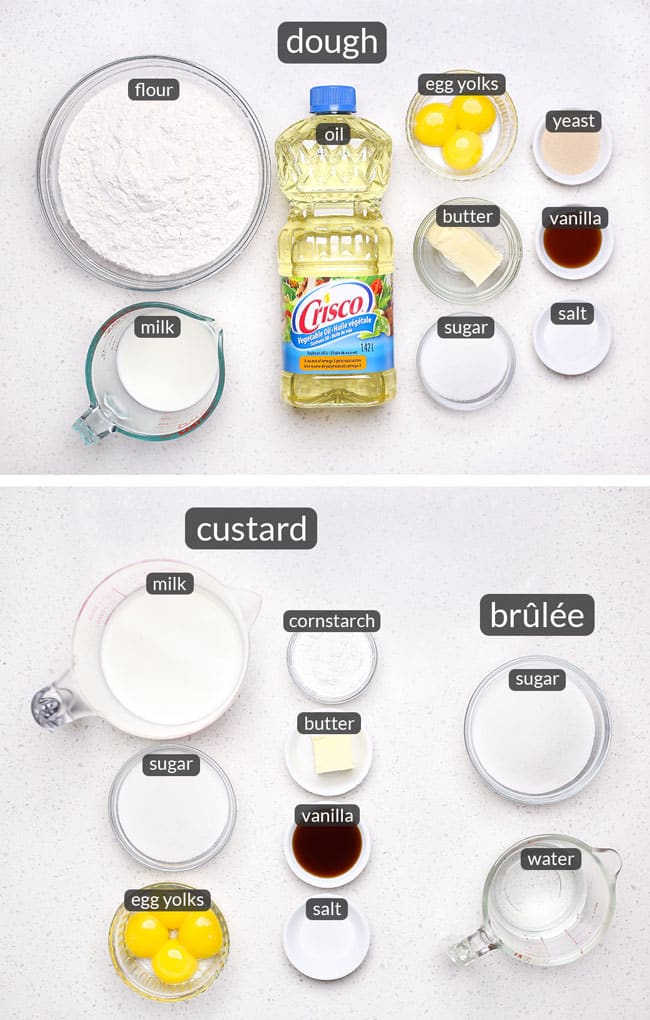
Ingredients in crème brûlée donuts
Click “Jump to Recipe” at the top of the page or keep on scrolling down to the recipe card for ingredient amounts and instructions. Read on for details and all the pertinent information you’ll need to fry up the most perfect donuts!
- Milk – Any type you have on hand. This will be used both for the dough and the custard.
- Yeast – Active dry yeast. Instant yeast will work too.
- Sugar – Granulated. Feel free to use less or more for the dough and/or custard, but it’s important to have plenty for the brûlée.
- Yolks – The dough and custard will use yolks. Want to use up those excess egg whites? Save them and make a few rounds of Whiskey Sours.
- Vanilla – Extract, paste, or fresh vanilla bean.
- Butter – Unsalted. I like to have full control over the sodium in my recipes.
- Flour – All-purpose. Bread flour will work too.
- Salt – To taste.
- Vegetable oil – For frying. Check below for details on choosing a perfect frying oil.
- Cornstarch – Also known as cornflour.
- Water
The best oil for frying donuts
When you’re choosing oil for any application, there are two points you need to have in mind: flavor and smoke point. In this situation, we need oil with little to no flavor and a high smoke point for the heat we’ll be taking it to. For example, something like extra virgin olive oil would be a bad choice since it has a strong flavor, and the smoke point is so low it would burn before we were even able to fry up one donut.
Keeping these two factors in mind, I’ve compiled a list of oils you can choose from for frying up not just donuts, but any fried delicacy:
- Vegetable oil
- Canola oil
- Sunflower oil
- Peanut oil
- Soybean oil
- Safflower oil
- Corn oil
- Cottonseed oil
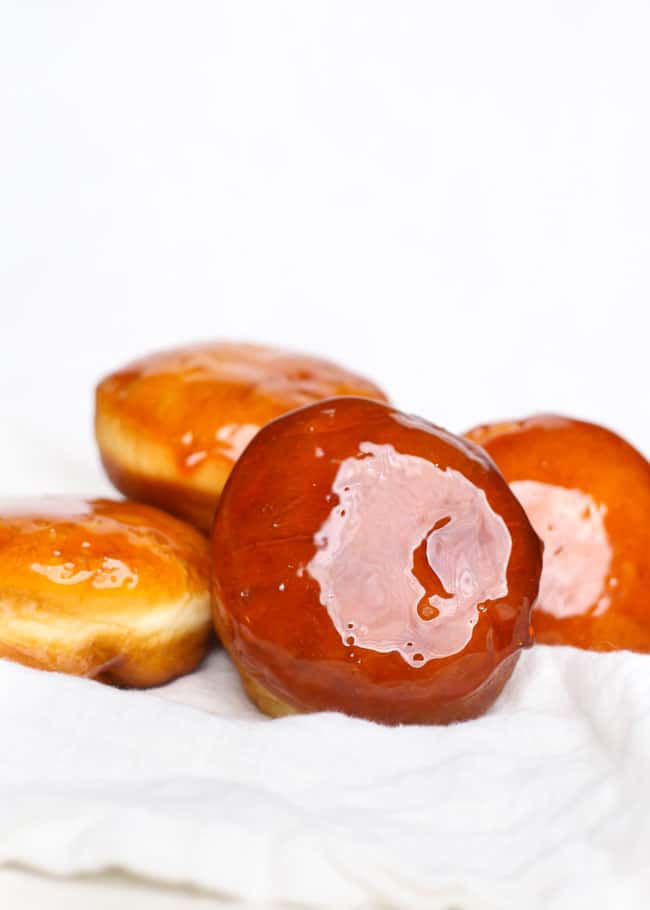
How to make crème brûlée donuts
Dough
- Whisk the milk, yeast, and 1 tsp of the sugar together. Let the mixture sit for 10-15 minutes until foamy. Add the egg yolks and vanilla to the yeast mixture. Stir well to combine.
- Add the yeast mixture, flour, butter, salt, and remaining sugar to the bowl of your stand mixer. Attach the dough hook to the mixer and start on low speed, working up to medium speed to combine the dough. Knead for 5-10 minutes until the dough is soft and elastic.
- Place the dough in a large, lightly greased mixing bowl. Cover with plastic wrap or a clean kitchen towel and allow the dough to rise in a warm, draft-free environment for 1-2 hours, or until doubled in size.
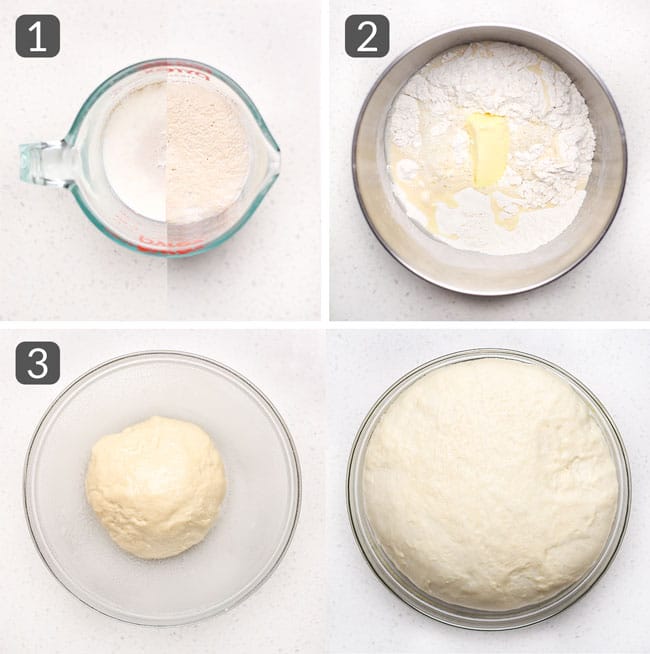
Custard
- Whisk the sugar, salt, and cornstarch together. Beat the egg yolks in a medium-sized mixing bowl just until smooth. Add the dry mixture to the egg yolks and continue to beat until combined and pale yellow, about 1 minute.
- Heat the milk in a saucepan over medium-high heat until it comes to a bare simmer. Remove the pan from the heat and carefully ladle the milk into the egg yolk mixture while whisking vigorously to avoid lumps. Pour the mixture back into the saucepan, and return it to the stovetop over medium heat.
- While continuously whisking, heat the mixture until bubbling and completely thickened. Remove the pot from the heat. Whisk the vanilla and butter into the custard until smooth, then transfer the custard to a bowl.
- Cover the custard with plastic wrap, carefully pressing the plastic directly against the surface of the custard to avoid a skin forming. Refrigerate for 1-2 hours or until completely cooled.
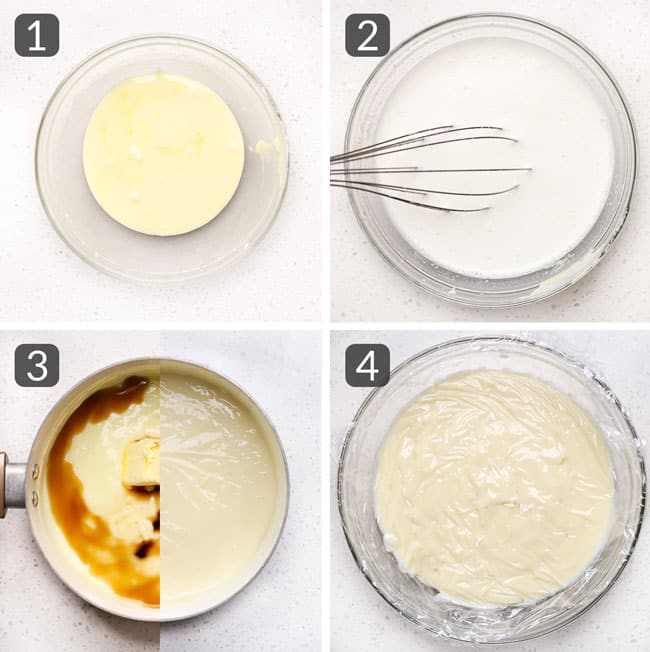
Donuts
- Punch the risen dough down and turn it out onto a lightly floured surface. Roll the dough out until about 1/2″ thick.
- Use a 3″ biscuit or cookie cutter to cut rounds from the dough. Knead the remaining dough back into a ball and continue to roll it out and cut rounds until you’ve used as much dough as you can.
- Place the rounds on a lightly greased baking sheet, leaving about 1″ of room between each round. Cover with plastic wrap or a clean kitchen towel and allow them to rise for 20-30 minutes, or until doubled in size.
- Heat the oil in a large pot to 360F. Carefully place the rounds into the hot oil, working in batches. Cook for 1-2 minutes, or until golden brown, flip and cook for another minute or until golden. Remove the rounds with a slotted spoon and allow the donuts to drain on a paper towel-lined plate while you fry the rest.
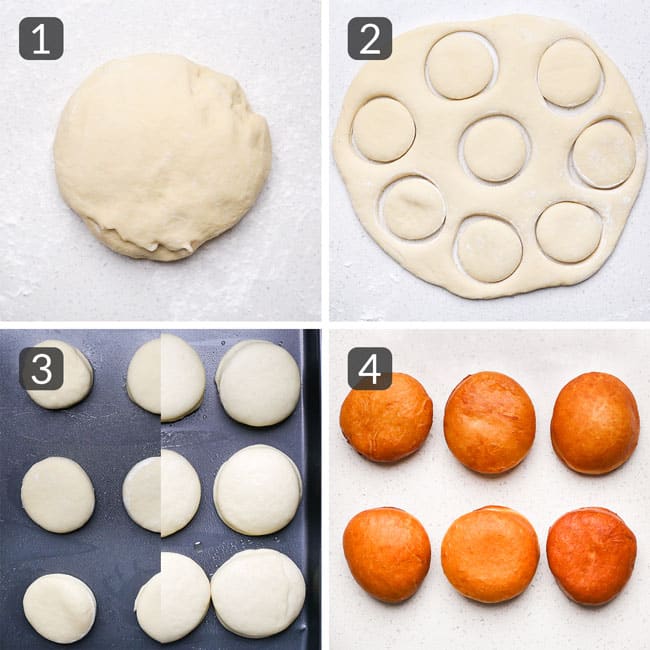
Fill & Brûlée
- Add the custard to a piping bag fitted with a piping tip. Insert a skewer or chopstick into each donut to create a pocket inside for the custard. Insert the tip of your piping bag into a donut and fill with custard. Repeat with the remaining donuts and custard.
- Add the sugar and water for the caramel (brûlée) to a small saucepan over medium-high heat. Once the mixture starts bubbling, reduce the heat to medium. Heat the sugar, giving the pan a gentle swirl occasionally, until it turns golden. Take the pan off the heat and swirl the pan until the color deepens slightly.
- Working very carefully, dip the top of each donut into the caramel. Wear a glove for extra protection on your hands. Lift the donut from the caramel and tilt it, away from your fingers, to let the excess drip for a few seconds, then place the donut aside to let it cool.
- Repeat with the remaining donuts. If you find the caramel in the pot is getting too stiff, return it to the heat, swirling the pan, until it warms up and becomes less viscous.
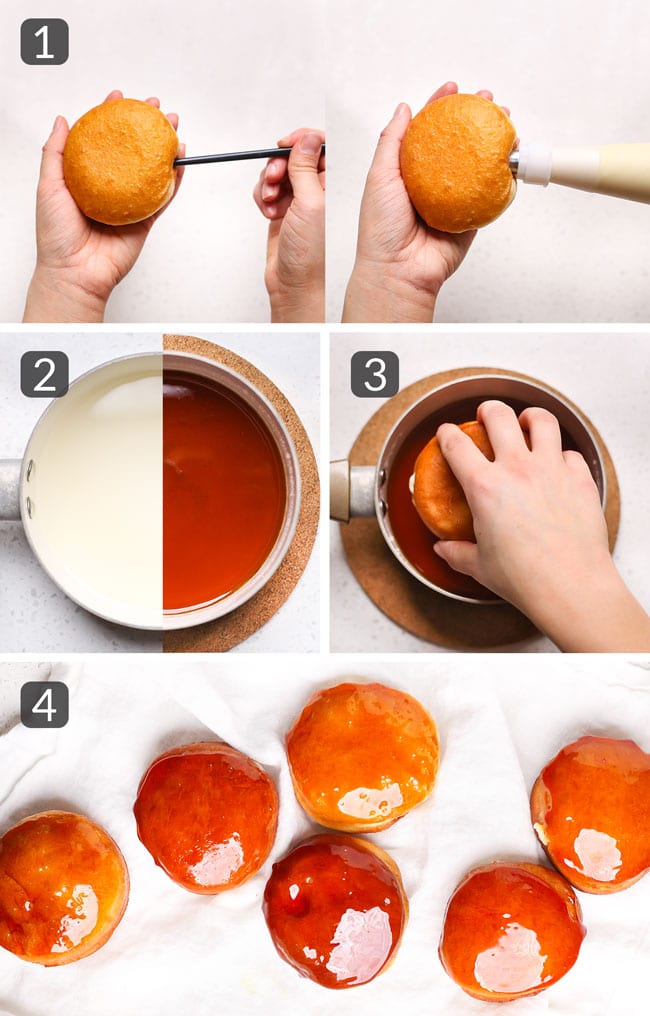
Troubleshooting your dough
Yeast
If your yeast didn’t foam up right off the first step, STOP and don’t continue with the recipe. In fact, this happened to me! It means, for whatever reason, the yeast didn’t activate. The dough will not rise. “Why?!”, you ask? Well, it could be:
- The water temperature was not in the Goldilocks range. If it’s too cold, the yeast won’t be able to be activated and thrive. Water that’s too hot will kill the yeast. We’re looking for, approx, 110F/40C, warm to the touch. Like baby formula. It doesn’t have to be exact! I usually just dip my finger into it and estimate lukewarm.
- My issue today: the yeast has died. Remember, yeast is a living organism. Even if it’s within the expiry date on the jar, if it’s dead, it’s dead. I was lucky enough to have an extra jar in the freezer as a backup. I tossed the milk and started fresh! Phew, no wasted dough.
- The yeast hadn’t been stored properly and, as a result, died early. I keep my yeast in an airtight jar in the freezer to help it last as long as possible.
Dough
Now that the yeast has bloomed nicely, let’s get the dough’s texture perfect. Every environment is different, with the main factor being humidity. Your dough should be soft to the touch without being sticky
- It’s too sticky: While the dough is still in your mixer equipped with the dough hook, add 1 tbsp of flour at a time, until completely mixed in, until your dough is perfect.
- It’s too dry: Again, while still in the mixer, add a splash of room temperature water or milk, mix completely, and repeat if needed.
The last piece of the puzzle is making sure that dough rises properly. Is it not rising as expected? Here’s what could’ve happened:
- It just needs more time. Even when I’m not blogging, I’ll snap a picture of my dough before rising to be able to compare. If you see some action, just give it a bit more time.
- It’s in an environment that’s too cold. The dough needs a warm and draft-free place for the yeast to thrive. I always rise dough in my oven. I’ll preheat it to the lowest setting, then turn it off. This creates a warm, cozy space without any cold breezes.
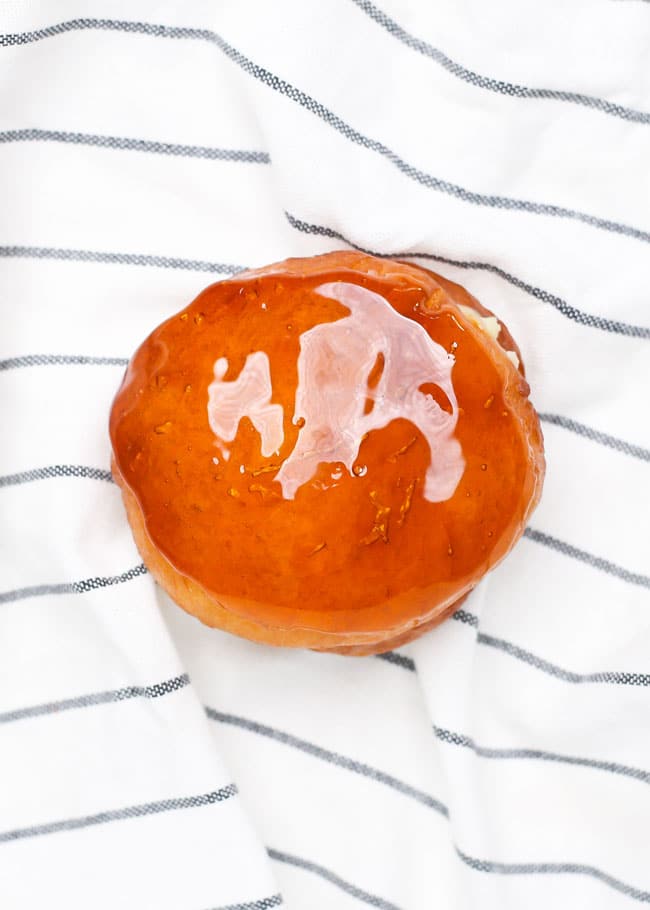
Tips for making perfect crème brûlée donuts
- If this is your first time making a yeast dough or you’re still pretty new to the process, read the section above, “Troubleshooting your dough” before starting.
- Attach a candy/frying thermometer to the side of the pot to keep the oil’s temperature consistent. This has to be the most important piece of advice I can give you!
- Only fry 3-4 donuts at a time. They will fry up so fast! The whole process will be done in no time, however, it will make your life a lot easier if the pot isn’t over-crowded.
- The donuts are going to puff up plenty while frying. Keep a slotted spoon handy to hold the donut(s) in place if they bubble up and try to flip around on you
- Work slowly while making the caramel. Trust me- I have burned a pot of sugar once or twice. This caramel happens so fast.
- It’s important not to rush the process. Keep the heat at medium after it starts bubbling and work slowly.
- Once I see some color start to form, I will take the pot off the heat every once in a while to swirl for 10-15 seconds to make sure I don’t over-cook the caramel. The pot is so hot it will continue to brown even after it’s off the heat.
- As you’re dipping the donuts in the caramel, you might notice the caramel starts to harden. You can return it to the heat and swirl the pot. It will thin out for you.
- Be careful! The caramel is VERY HOT. Wear a glove to protect your hand while dipping the donuts in the caramel.
How to store leftover crème brûlée donuts
Make sure your donuts have fully cooled down before storing them. Transfer to an airtight container or large freezer bag and store in the fridge. They’re best eaten within 2 days to enjoy the dough at it’s freshest and best-est. I like to zap mine in the microwave for 10-20 seconds to soften them up a bit.
The brûlée may feel a tiny bit sticky, but don’t worry! It’s just absorbed a little bit of moisture from the air. It’ll still be crunchy when you bite down. It’s a messy donut, anyway!
I don’t suggest storing these in the freezer. The custard may separate a bit a create an odd consistency once thawed. The unfriend donuts, however, can be frozen right after being cut into rounds. Their second rise can happen on the counter, at room temperature, as they thaw out.
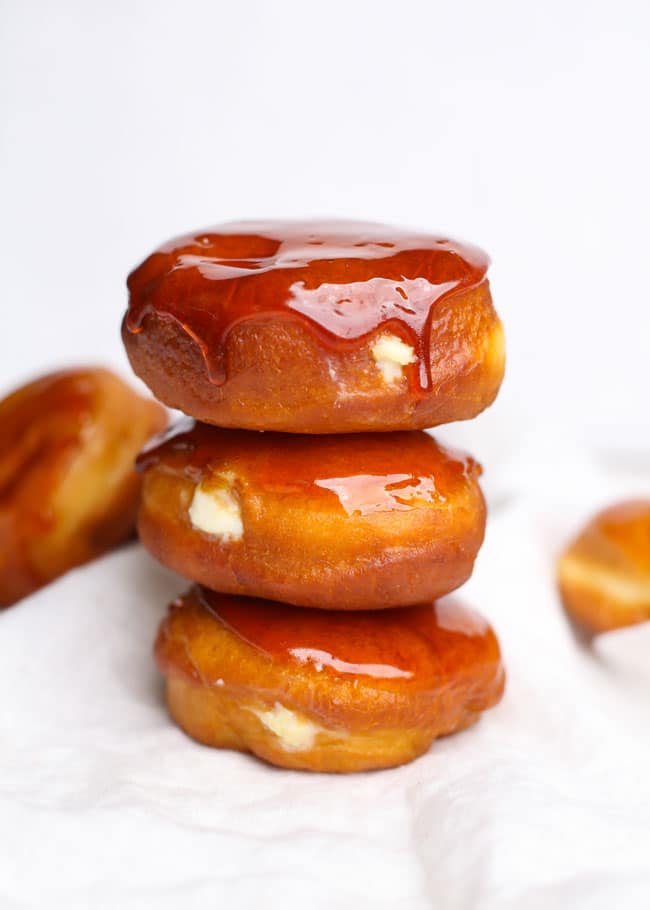
Sweet tooth still hankering? Try these:
- Crème Brûlée
- Triple Chocolate Banana Cake
- Easy 3 Ingredient Fudge
- Mini Mixed Berry Cheesecake Pies
- The Best Banana Bread
[ss_social_follow]
Crème Brûlée Donuts
Ingredients
Donuts
- 1 cup milk lukewarm
- 1 tbsp active dry yeast
- 1/3 cup sugar granulated
- 3 egg yolks
- 1 tsp vanilla
- 4 tbsp butter softened
- 4 1/4 cups flour all-purpose
- 1 1/2 tsp salt or to taste
- vegetable oil for frying
Custard filling
- 1/2 cup sugar granulated
- 1/2 tsp salt or to taste
- 3 tbsp cornstarch
- 2 cups milk
- 4 egg yolks
- 2 tsp vanilla extract
- 2 tbsp butter unsalted
Brûlée
- 1 cup sugar granulated
- 1/4 cup water
Instructions
Dough
- Whisk the milk, yeast, and 1 tsp of the sugar together. Let the mixture sit for 10-15 minutes until foamy. Add the egg yolks and vanilla to the yeast mixture. Stir well to combine.
- Add the yeast mixture, flour, butter, salt, and remaining sugar to the bowl of your stand mixer. Attach the dough hook to the mixer and start on low speed, working up to medium speed to combine the dough. Knead for 5-10 minutes until the dough is soft and elastic.
- Place the dough in a large, lightly greased mixing bowl. Cover with plastic wrap or a clean kitchen towel and allow the dough to rise in a warm, draft-free environment for 1-2 hours, or until doubled in size.
Custard
- Whisk the sugar, salt, and cornstarch together. Beat the egg yolks in a medium-sized mixing bowl just until smooth. Add the dry mixture to the egg yolks and continue to beat until combined and pale yellow, about 1 minute.
- Heat the milk in a saucepan over medium-high heat until it comes to a bare simmer. Remove the pan from the heat and carefully ladle the milk into the egg yolk mixture while whisking to avoid lumps. Pour the mixture back into the saucepan, and return it to the stovetop over medium heat.
- While continuously whisking, heat the mixture until bubbling and completely thickened. Remove the pot from the heat. Whisk the vanilla and butter into the custard until smooth, then transfer the custard to a bowl.
- Cover the custard with plastic wrap, carefully pressing the plastic directly against the surface of the custard to avoid a skin forming. Refrigerate for 1-2 hours or until completely cooled.
Donuts
- Punch the risen dough down and turn it out onto a lightly floured surface. Roll the dough out until about 1/2" thick.
- Use a 3" biscuit or cookie cutter to cut rounds from the dough. Knead the remaining dough back into a ball and continue to roll it out and cut rounds until you've used as much dough as you can.
- Place the rounds on a lightly greased baking sheet, leaving about 1" of room between each round. Cover with plastic wrap or a clean kitchen towel and allow them to rise for 20-30 minutes, or until doubled in size.
- Heat the oil in a large pot to 360F. Carefully place the rounds into the hot oil, working in batches. Cook for 1-2 minutes, or until golden brown, flip and cook for another minute or until golden. Remove the rounds with a slotted spoon and allow the donuts to drain on a paper towel-lined plate while you fry the rest.
Fill & Brûlée
- Add the custard to a piping bag fitted with a piping tip. Insert a skewer or chopstick into each donut to create a pocket inside for the custard. Insert the tip of your piping bag into a donut and fill with custard. Repeat with the remaining donuts and custard.
- Add the sugar and water for the caramel (brûlée) to a small saucepan over medium-high heat. Once the mixture starts bubbling, reduce the heat to medium. Heat the sugar, giving the pan a gentle swirl occasionally, until it turns golden. Take the pan off the heat and swirl the pan until the color deepens slightly.
- Working very carefully, dip the top of each donut into the caramel. Wear a glove for extra protection on your hands. Lift the donut from the caramel and tilt it, away from your fingers, to let the excess drip for a few seconds, then place the donut aside to let it cool.
- Repeat with the remaining donuts. If you find the caramel in the pot is getting too stiff, return it to the heat, swirling the pan, until it warms up and becomes less viscous.
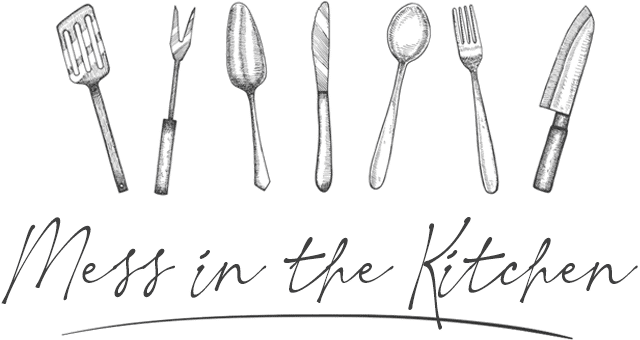
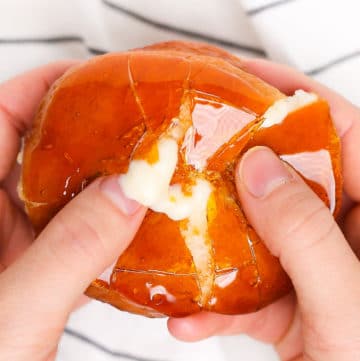
Why are my donuts look cooked on the outside but in the inside it’s raw please help me. Thank you.
I’d say the temperature of your oil is too hot – I recommend using a thermometer to keep a close eye on the temperature.
I made over 500 of these last week at work. I own a modern smokhouse and bake daily of my customers. Started out with 2 dz and they were such a hit that I got orders for them! They were fabulous. I found the dough nit as soft as I liked so I tweaked it to my liking. The filling I used 35 % cream and milk with vanilla bean caviar. Lots of burns on my poor fingers but they were DIVINE! I can see I’ll be making a lot of these. Tyvm!
How long would you say the custard can last in the fridge for? 🙂 I have some left and wasn’t sure if I could use it again or need to throw it away, thanks!
Your custard will last 2-3 days in the fridge 🙂
I made these in the air fryer and they turned out amazing!!!
Hey Wren! I didn’t know you could make these in the fryer! Do you mind sharing what temperature you used to cook the dough and for how long? Any tips for doing it! Thank you 🙂
can i used instant dried yeast instead of the active dry yeast?
For sure!
Super tough, dry, monstrous dough. Custard was beyond amazing, will definitely save that recipe!
If you read the post, you’ll see a section for troubleshooting 🙂 If it’s dry, that can be because of low humidity, or because the flour was a bit more packed down in your bag, resulting in more dense cups. You can add more water or milk in this case and your dough will be perfect.
hey, how do we store these?
Keep them in an airtight container in the fridge. They’re definitely best fresh since the caramel will absorb moisture from the donuts and soften. Still delicious, but not the same satisfying crunch! If you’d like to make them ahead, you can prep and fill the donuts, then dip the tops in caramel the day you serve them.
I made to dough but forgot to add the sugar to the dough. I have already kneaded the dough and I don’t know if I should add the sugar now or just leave it.
Oh my goodness!!!!! I can’t believe I found this recipe in English. Previously only saw it in Hungarian. Can’t wait to try!!!!!
Yay I’m so glad! I hope you love it!
Hey Nicole, I started making recipe. I followed all ingredients and order but my dough stayed dry and crumbly. I went back over everything and I don’t know what i did wrong?
Hey Katie! in the “Troubleshooting Your Dough” section, you’ll see all the info for issues with dryness. There can be so many things that affect your dough- humidity, how you measure the flour, etc. If it’s a bit dry, that’s easy to fix! Just add a tbsp of milk or water at a time, kneading between additions, until it’s nice and smooth.
Would you be able to pour or maybe even spoon/ladle the caramel on top of each donut if they were resting on a cooling rack or is dipping the better method?
Hey Ryan! Sorry for the late reply- we have had a big move to a new province and I took some time off. You can definitely give that a try! The caramel will end up hardening a bit on the spoon, but just leave it in a simmering pot of water and it’ll all come off.
Hi! I wanna try this recipe but in my family we try to avoid fried food (history of high colesterol in the family), we don’t even buy vegetable oil anymore. But it’s my sister’s birthday in a couple of months and I want to try this one because she loves donuts and creme brulee. Could I make the donuts in an Air-Fryer? If so, for how long do I leave them in and in what temperature?
Thank you!
Hi Gigi! Apologies for the late reply, we had a big move to a new province and I finally have access to my computer again! These are the best baked donuts I’ve tried: https://natashaskitchen.com/baked-donuts/
You can make those, and then use my method for the filling and caramel topping!
Hey! Do you have a high altitude recipe for the dough? I live at 9,000 ft and it’s very difficult to get things to rise. Thanks!
Hey Hannah! This is my favourite high-alt baking guide. Apply any adjustments that you see fit into the donut recipe and it should work perfectly for you: https://www.kingarthurbaking.com/learn/resources/high-altitude-baking
I want to make these for a brunch but it seems like a lot to all get done in the morning. I’d like to make it part way the night before and finish the morning of. I think the custard will be easy to keep over night. At which point do you think it would be best to store the dough overnight? Before (after step 3 under dough) or after cutting out the doughnuts (after step 3 under donuts)?
The custard can definitely be done the night before! Just make sure to keep it stored with that sheet of plastic wrap pressed against the surface to avoid a skin forming. I would put the dough into the fridge right after kneading, then allowing it to rise as it comes to room temperature the next morning. It will rise a little bit in the fridge, but not a lot.
Hi!
My donut dough always comes out tough – I’ve followed the recipe to a T and made sure I used the spoon method to measure my flour.
Would you be able to post this in grams?
Also do you have the problem of your brulee top crystalizing the next day?
This sounds like a yeast issue! I have a section about the yeast and how to make sure it’s properly activated under “Troubleshooting Your Dough” in the blog post. Yeast is what will give you that airy fluffiness. I do have the ingredients in grams and ml; there’s a metric option underneath the list of ingredients that will automatically convert everything.
I didn’t see the brulee crystalizing! It softened slightly, but it still looked glossy.
Hi!
I’m sure the yeast was properly activated, I make bread a lot! 😁
It looked to me as if the dough had too much flour, I’ve heard that different flour can have different protein compositions – which is why I asked for the weights!
I didn’t see that option! Thank you!
I’m going to try again (:
Perfect! Yeast is very tricky and I find a lot of people can have issues with it- I’m glad you have experience. Each environment is different and humidity can also play a role in the process. Under “Troubleshooting your dough” I’ve also written that if your dough feels dry, you can add a splash of water or milk to mix in and soften it up. I hope you love them!
I had this exact problem too, not enough liquid at all, and the yeast was fine
Did your dough rise nicely after kneading? If it doesn’t, that will be the biggest indicator of a tough donut. I do have a section called “Troubleshooting your dough” because yeast doughs are very particular and different environmental factors including temperature and humidity will require slight changes in the recipe. Give that section a read and your dough will come out perfectly!
These are now my favorite donuts now! Clearest recipe I found on these!
Wow
The Textures!!! Easier than I thought they would be. These will forever blow my mind!